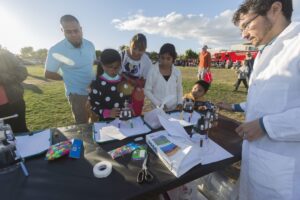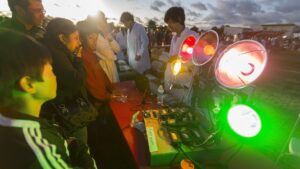The goal of STEM Learning Ecosystems is to provide pathways that enable young people to become engaged, knowledgeable and skilled in the STEM disciplines. Engaging families and community members in hands-on STEM activities through a Science Carnival or similar event provides a memorable way to establish those pathways.
Themed events can be an impactful way for members of an Ecosystem or community to work together and make connections with a variety of students. Since 2009, the team at California State University Channel Islands has hosted a Halloween-themed science carnival. Other members of the VC STEM Ecosystem joined the team to present the 2016 Science Carnival. 2,182 parents and PK-8 kids attended and participated in nearly 100 different hands-on STEM experiments, including a brand-new PK zone.
This year a professional development component of the Carnival was made available to PK-12 teachers so they could learn more about the hands-on science activities and how to implement them in their classrooms. Sixteen  individuals attended this event, touring the Science Carnival when there were few people present prior to the start of the Science Carnival and interacting with the presenters in a more intimate way. They were able to capture a QR code to connect directly to instructions for the activity on the Science Carnival Activities website. The website includes a listing of supplies needed, a procedure for the activity, background science content knowledge and connection to science standards, and information for teachers on how to implement the activity.
individuals attended this event, touring the Science Carnival when there were few people present prior to the start of the Science Carnival and interacting with the presenters in a more intimate way. They were able to capture a QR code to connect directly to instructions for the activity on the Science Carnival Activities website. The website includes a listing of supplies needed, a procedure for the activity, background science content knowledge and connection to science standards, and information for teachers on how to implement the activity.
VC STEM partners were well-represented and ran several of the science activities. Some of these partners included:
- Local community colleges: Oxnard College, Moorpark College, and Ventura College
- Child Development Resources
- Ventura County Libraries
- Society of Hispanic Professional Engineers
- Oxnard Unified High School District Academies
- Amgen
- California Lutheran University
- CSU Channel Islands student clubs: Free Radicals Chemistry Club, Physics Club, Biology Club, Green Generation Club, Computer Science Club, Red Cross Club, and Nursing Club.
Here are some tips learned from years of experience hosting the Science Carnival:
- Leverage the skills of participating organizations for creativity and development: the Science Carnival Activities website was built over two years by CSU Channel Islands students enrolled in a service learning class.

Young students at the Annual Science Carnival - Create partnerships between higher ed and community organizations. Science Carnival volunteers were
initially all CSU Channel Islands students, but now volunteers are recruited from VC STEM partners including the nearby military base as well as local community colleges and a private university. Professional organizations also have been great sources of volunteers. - Consider having an organization adopt an activity and agree to bring it back year after year.
- Use the Science Carnival Activities web site for some starter ideas and activities when forming your own event.
- Consider using free/ low-cost volunteer websites (e.g., SignUpGenius) to recruit and organize volunteers.
- Establish a VIP Scientist program where schools in the partner school district identify elementary and middle school students to serve as volunteers. They get to wear a lab coat and a VIP button— a sort of “ride along” with mentoring by the college students/ community members running the activity.
Children having fun with science are more likely to engage in and pursue further STEM education opportunities. The Science Carnival has proved to be a fantastic community event that builds relationships within a variety of organizations while giving students a fun science experience.
STEM Learning Ecosystems members, login to the Community of Practice and continue the collaboration: tell about STEM learning events you’ve coordinated or are planning, send links to websites for those events, and share tips or questions with your peers.
Author: Dr. Phil Hampton, Professor of Chemisty, CSU Channel Islands
Learn more about the STEM Learning Ecosystems initiative and find resources for your Ecosystem at stemecosystems.org. Join our online conversations on Twitter @STEMecosystems and #STEMecosystems and on Facebook.
